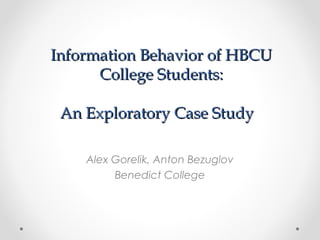Information Behavior Of HBCU Students: A Case Study
- 1. Information Behavior of HBCU College Students: An Exploratory Case Study Alex Gorelik, Anton Bezuglov Benedict College
- 2. Information Literacy • Essential • Personal • Inadequate
- 3. Wilson’s (1994) Model of information behavior
- 4. Study objectives: • Explore the elements of the Wilson’s model, focusing on o “Needs” o Information seeking behaviors o Demands on info systems / other sources • Build an exploratory case study of information behavior (at a large HBCU)
- 5. Method: • Scope: Benedict college students from HASS and STEM (n=43) • Information search task o Search engine requests intercepted by a server, compiled specifically for the study • Exit Interview • Recorded observations
- 6. Tools • Proxy server intercepts all traffic from the machine to the Web • If (1) traffic goes to Google Search Engine and (2) it contains a keyword, the results of HTTP Get are modified; • The first search result is changed: For instance Solipsism -> Solarism
- 7. Tools
- 8. Findings o Reasons for preferring a specific resource: o Speed of access (20%) o Reliability / Credibility (17%) o Authoritativeness (17%) o Convenience (15%) o Stem different from HASS, Seniors different from Sophomors / Juniors
- 9. Findings  Major of respondent Mass Comm / English Comp Sci / Engineer. Total Count Col. N % Count Col. N % Count Col. N % Dictionary 11 44.0% 10 55.6% 21 48.8% EBSCO web 4 16.0% 1 5.6% 5 11.6% interface Derived ranks of Electronic sources 11 44.0% 9 50.0% 20 46.5% Dictionary Google search 15 60.0% 16 88.9% 31 72.1% Total 25 100.0% 18 100.0% 43 100.0%
- 10. Findings Classification - Collapsed  Senior Junior/Soph. Total Count Col. N % Count Col. N % Count Col. N % Dictionary 10 55.6% 11 44.0% 21 48.8% EBSCO web 3 16.7% 2 8.0% 5 11.6% interface Derived ranks of Electronic sources 10 55.6% 10 40.0% 20 46.5% Dictionary Google search 12 66.7% 19 76.0% 31 72.1% Total 18 100.0% 25 100.0% 43 100.0%
- 11. Information behavior o Behavior dominated by considerations of o speed of access o clarity o accuracy o convenience / familiarity
- 12. Information behavior o Demands on sources: o speed o straightforward presentation of information
- 13. Information behavior o “Success” = ability to quickly match the answer to the question
- 14. Information behavior o About half of those presented with a “modified” answer failed to detect that o The necessity to critically evaluate and corroborate is trumped by the considerations of speed, clarity and convenience of access
- 15. Information behavior o Students recognize the need to corroborate the information o …even if not all of them may decide to do so
- 16. Information behavior o This study is a “proof of concept”, what’s next? o looking at the gap between the self- reported level of information literacy and the actual performance on test tasks o comparing the resulting among HBCUs and mainstream academic institutions
- 17. Questions, please? Q?
















